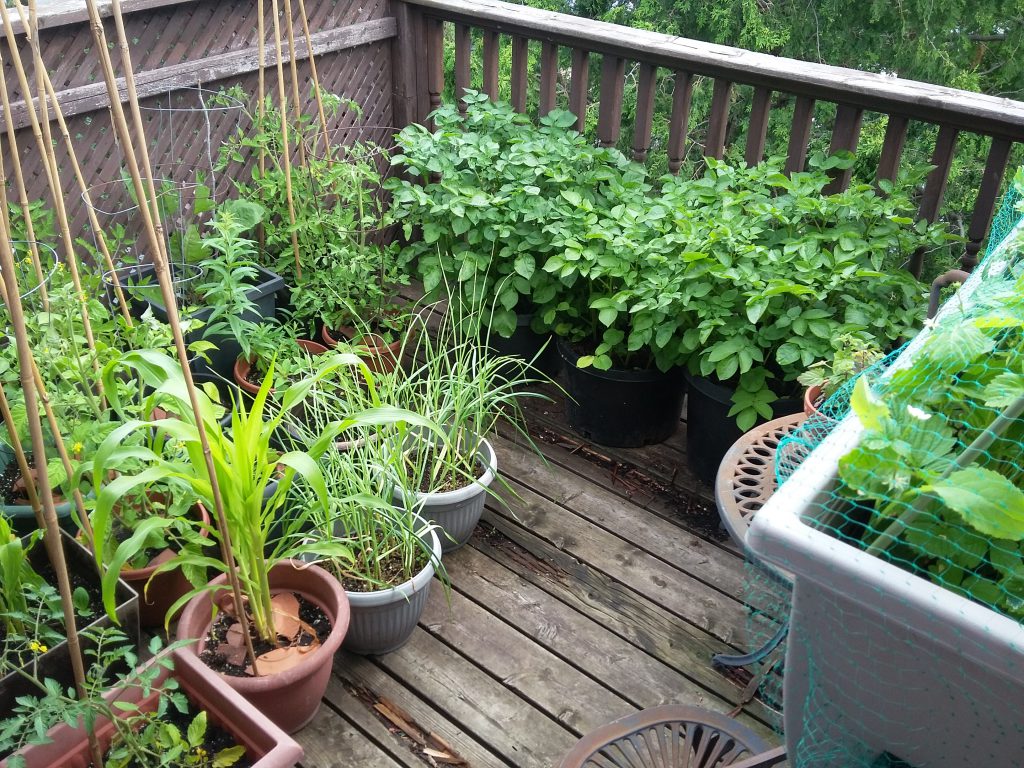Every morning, shortly after dawn, I go up to the third floor deck to tend to the garden, sniff the scents of the new morning, and take a census of my horizon of trees.
Every morning has a different scent. This morning the air had a northern, almost September smell, until the sun breached the horizon. Yesterday the air was redolent with woodsmoke, drifting upon a wind that soughed in the cedars. The day before that the air smelled of the lake. In the hour after dawn the city, or my part of it, is silent. No traffic sounds, no sirens, not even an airplane. This morning the air is perfectly still, and only the birds and I are present to sing the morning open. The air is scented with ailanthus blossoms, opening about a week later than usual but as secretive and summery as ever.

This year I am growing at least five varieties of tomatoes, including “Summerlast’ (early-fruiting patio-sized supposedly long-fruiting determinate tomato plants, of which I have six plants going), ‘Rapunzel’ (a newish hybrid tomato that reportedly grows long, gorgeous tresses of cherry tomatoes; this is by far my tallest tomato plant so far, heading for five feet already as it begins to flower), San Marzano (two very sturdy plants, both flowering now), an unknown (because I failed to save the labeled starter pot) tomato plant I bought at the Junction Farmers’ Market, and several ‘heirloom’ tomatoes.
‘Heirloom’ is a bit of a misnomer, as there are many heirloom varieties of tomatoes. Heirloom or heritage tomatoes are typically open-pollinated, older, non-commercial cultivars. Reportedly they tend to lack the disease resistance and uniformity of commercial cultivars, but in compensation they are inherently more biodiverse and interesting to grow, and produce tomatoes of sometimes wildly varying sizes, colours and shapes. My ‘heirloom’ tomatoes came labeled as such at the Canadian Tire garden centre, with the note that each plant might grow quite differently depending on its variety.
This has definitely been my experience this year. Each of my heirloom tomato plants looks quite different. All are vertically inclined, although not rampantly so, and their leaves and blossoms are somewhat idiosyncratic. My favourite, so far, is the heirloom tomato pictured above, whose leaves emerge curled and inverted, almost as if blighted, but then unfurl, completely hale. The blossoms are also unusual, large and multi-layered. I have read that large blossoms produce large tomatoes, and am looking forward with considerable curiosity to see what this heirloom plant produces.
On the third floor deck I am also growing two containers of corn (this year’s wildcard), zucchinis (only two of which survived the early ravages of squirrels digging up the seeds; zucchini are supposedly easy to grow, but each year mine succumb to some new peril and/or fail to produce fruit), three large tubs of very large red potato plants, two eggplants, two sweet peppers, red onions, everbearing strawberries, garlic, and several varieties of herbs (lemon verbena, pineapple sage, lavender, basil, catnip).

Most of my 22 varieties of herbs (this year’s herbs include lavender, basil, catnip, lemon verbena, lemon thyme, sage, oregano, rosemary, dill, tarragon, rue, summer savory, winter savory, marjoram, fennel, cilantro, parsley, pineapple sage, chamomile, sorrel, curry plant, borage) are growing on the second floor front balcony (shown below), alongside a few more tomatoes, bush beans, carrots, beets, more garlic and more red onions. Our radish have been pulled, and I haven’t yet decided whether to simply seed more dill or risk salad greens in the summer heat in their currently vacant container.

Sometimes I sorrow over not being able to grow more vegetables at ground level on our shady city property (currently our ground-level growing is limited to rhubarb, raspberries and red currants), but between patios, verandahs, balconies and decks we are able to dedicate about as much square footage to vegetables and herbs as we might manage in the soil, without the same risks of soil depletion and problems with pests.

Still, at some point we will retire from urban life, and then I will have a half-acre vegetable garden, an arbor for fruit trees, and a kitchen garden filled with herbs.